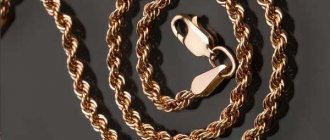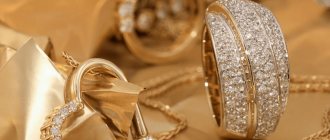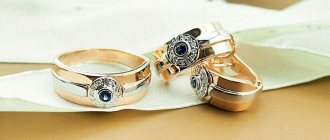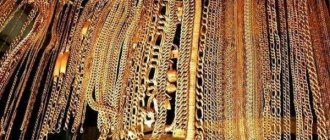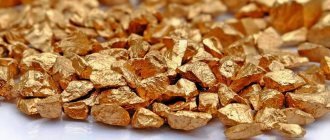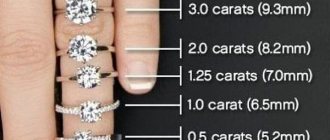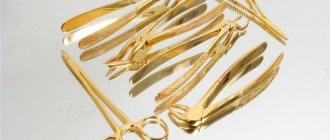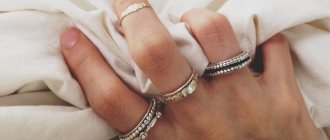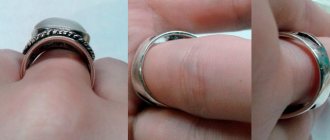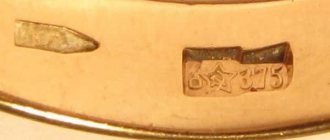The Agency reminds that the sale of jewelry without an imprint of state hallmarks of the Russian Federation, as well as imprints of registered manufacturers (for products of Russian manufacture) is not permitted.
Products made of precious metals and precious stones must bear imprints of the state hallmark of the Russian Federation and the name of the manufacturer or If the product is imported, then the name plate may be absent, but the imprint of the hallmark inspection stamp of the established type must be present.
The state hallmark is minted on products, and is also applied using an electric spark or laser. It indicates the code of the Assay Supervision Inspectorate (one letter); an ID badge representing a female head in a kokoshnik in profile, turned to the right (from 1958 to 1993, the ID badge was an image of a hammer and sickle against the background of a five-pointed star); sample mark.
The exception is jewelry and other domestically produced silver products weighing up to 3 grams inclusive (excluding inserts), the sale of which is allowed without a state hallmark.
Also, the jewelry must have a label indicating the name of the product and its manufacturer, the type of precious metal, article number, standard, weight, type and characteristics of precious stone inserts, and the price of the product.
The name of the product and the seller, sample, type and characteristics of the precious stone, article number, date of sale and price of the product, signature of the person directly selling the product must be on the sales receipt . Certificates are also provided for cut natural gemstones.
For precious stones in the form of inserts in jewelry, a certificate is not required; it is replaced by a tag.
Reference
The following standards are established in the Russian Federation: platinum - 950, 900, 850; gold – 999, 958, 750, 585, 500, 375; silver – 999, 960, 925, 875, 830, 800; palladium – 850, 500.
On the tags of jewelry with inserts of precious stones ( diamonds, emeralds, rubies, sapphires color and purity must be indicated ; for semi-precious ones - topazes, amethysts, peridots, garnets - the weight of the insert is simply indicated without any - or cleanliness characteristics.
The marking on the tag of jewelry with diamond inserts may look like this: 1Br Kr57 – 0.470 – 4/6A. Here 1Br is the number of diamonds in the product, in this version there is only one; Kr57 - cut shape, in this case round with 57 facets; 0.470 - total weight of stones in carats; 4/6A - characteristics of color groups / defects, geometric parameters (the number before the line means color, and the larger it is, the more yellow the crystal has. The second number indicates the transparency of the stone. Only artificial stones are absolutely transparent. Any natural stone has cracks, foreign inclusions, defects that are visible only under a magnifying glass or microscope).
Share:
Post Views: 112
How to distinguish real gold from fake
Buying jewelry is not only a pleasant thing, but also a responsible one. Authenticity of a far from cheap purchase is the main task facing every buyer
It is not always possible to contact a jeweler for advice, so it would be a good idea to arm yourself with some expert advice.
Trust but check
One of the programs on Channel One said that 50%, if not more, of all gold sold in the country is fake. Even if a product is stamped, this is not a guarantee of its authenticity. I had to turn to a jeweler I knew for clarification:
— If even the most popular jewelry store offers a gold product at a price of less than 1.5 thousand rubles per gram as part of a discount promotion or not, it is most likely a fake. No matter what, you should definitely watch the sample. To do this, you can prudently take a magnifying glass with you.
A real 585 gold hallmark looks like this: a spatula-shaped imprint is pressed into the metal, inside there is the face of a girl in a kokoshnik, who is looking to the right directly at the numbers 585, as well as a letter that designates the inspector who hallmarked the product. If the stamp depicts not a girl, but a hammer and sickle, then the product is made in Soviet times.
In those days, by the way, there were practically no fakes. In the store you can check the product for teeth, if the seller allows it. Gold is a soft metal and can be easily bitten and may even leave small teeth marks.
585 purity means that the material contains 58.5% pure gold. The lowest standard in our country is 375. Oddly enough, the number 375 can often be found on jewelry made in Germany and England. Sometimes you can find jewelry made of gold of the 957th and 999th standard; they are the most expensive.
Here are some more simple tips shared by a professional:
— Buy gold exclusively in stores. You can ask the seller for a certificate for the selected product to ensure its authenticity.
— It’s good if, in addition to the sample, the product also bears the imprint of the manufacturer. This is a guarantee of high quality and responsibility for the product.
— If you throw a ring edge-on on a tiled floor, it will bounce, other metal will not.
— If you look at a gold item in sunlight and in the shade, it will be the same color in both cases.
Igor Popov, a geologist, explained why gold jewelry can have different shades and prices:
— The color of a gold product depends on the impurities in the alloy. White gold is an alloy of platinum, palladium and nickel, the red tint comes from cobalt, and the yellow tint comes from copper. Today it is fashionable to wear rose gold with the addition of silver and copper, as well as black gold, which is mixed with chrome and cobalt. Often the buyer pays not for the purity of the gold, but for fashion.
In this case, there is a risk that over the years the expensive purchase will lose value. If gold is purchased for the purpose of investing money, then it is better to opt for a traditional yellow product.
Baby or pacifier?
Armed with the advice of a jeweler, I decided to check the authenticity of some jewelry at home. For the purity of the experiment, I took an old ring that I inherited from my grandmother and a ring that I bought several years ago. I decided to use several methods at once to be sure of the results obtained. For the experiments you needed: a magnifying glass, soft cloth, magnet, iodine.
In the first case, I applied a drop of iodine to my rings, waited five minutes and wiped it off with a soft cloth. Not a trace of my grandmother's ring remained on the fabric. But my new one left a dark stain.
The jewelry was tested with a magnet for the second time. Once again, the Soviet decoration remained at its best, resisting the force of the magnet. And my ring instantly became treacherously magnetized.
I called the jeweler and told about my experiences, to which I heard the answer:
“You won’t be able to detect a fake coated with high-quality gold plated using such primitive methods.” Therefore, if you have the slightest doubt, it is better to contact an expert. And that means they sold you an outright fake.
Pebbles, not simple ones, but are they precious?
The authenticity of precious stones can also be determined by eye. The first thing you need to pay attention to is hardness. If you run a stone across the glass, it will leave a mark. Natural stone is always heavier than glass or synthetics and colder to the touch; it cannot be cheap. If you are offered a stone at a huge discount, this is a reason to think about it. Cleanliness, excessive shine and unnatural color highlights will also give away a fake. There are no ideal stones in nature.
Petr Navorushev, a finishing master, shared his literally precious experience:
— Russian cutting is still famous all over the world; it is the best in quality, proportions, perfect polishing, and symmetry. Precious stones of the first group are the most expensive and rare. These include five specimens: diamond, emerald, sapphire, alexandrite, ruby. They are most often counterfeited.
For example, there are about a dozen imitations and synthetics for diamonds. Natural emerald is cool to the touch. If you look at it through a magnifying glass, you can see the pattern of the stone. Tubular patterns will indicate a synthetic origin. In Buryatia, and not only, amber is very popular. If it is real, it will attract strings to itself and give an electric shock if you rub it with a woolen rag. Real pearls squeak on the lips and should not be too cheap.
You should not buy into the blood-red color of a ruby; such stones are very rare, and its price is close to the cost of a diamond. If you come across such a copy, you should know that it is a fake.
Recently, a lot of good quality synthetic sapphires have appeared on the market. A real stone, when viewed through a magnifying glass, has gas bubbles and color zones.
If the jewelry is expensive, then it must be accompanied by a gemological certificate. The document must reflect the most comprehensive information about the jewelry. This certificate has a living blue seal, the inscription “Gemological Certificate” or “Gemological Expertise Conclusion” and full detailed information about the parameters of the stone (weight, color, purity, cut quality) and metal (fineness, mark), as well as the artistic value of the product ( copyright, circulation).
All these factors are analyzed and put together by an expert gemologist, who ultimately makes a price verdict for the jewelry. It is also necessary to pay attention to the qualifications of the specialist, which must be indicated in the certificate.
This is useful to know
If you have any doubts about the authenticity of your jewelry, you can take it for examination. It is carried out in any jewelry workshop in the city. Weighing the product costs 25 rubles, testing with reagents costs 25 rubles. True, they will not issue a supporting document there. An official certificate can only be obtained from the Trans-Baikal Instrument Supervision Inspectorate at the address: st. Tereshkova, 9, tel.: 8 (3012) 43-92-11. Reception of citizens is carried out on Wednesdays from 14.00 to 17.00 on a first-come, first-served basis.
Photo: website zoloto.blogspot.com
Author: Anastasia Chernigovskaya
Kokoshnik: decoration, amulet and status indicator
It is no coincidence that at the beginning of the word “kokoshnik” you hear the onomatopoeia “ko-ko”: the whole point is that the name of the headdress comes from the ancient Russian word “kokosh” - this is what the ancestors called chicken. It is difficult to say when exactly the kokoshnik appeared in Rus', but references to a piece of clothing that is similar to the kokoshnik can be found back in the 10th century: in particular, the Novgorod chronicle describes a women’s headdress, which consists of a comb and a plate.
However, it is difficult to imagine that in an instant all women in Rus' acquired the same headdress. Firstly, the kokoshnik was not a cheap pleasure - until some time only noble ladies, most often the wives of nobles, could afford it, and secondly, from province to province there were different kokoshniks: in Kostroma, for example, there was one, in Pskov - the other, in Vladimirskaya - not like either one or the other. Somewhere it was made in the shape of a crescent, somewhere it looked like a crown, somewhere it even resembled an arrowhead.
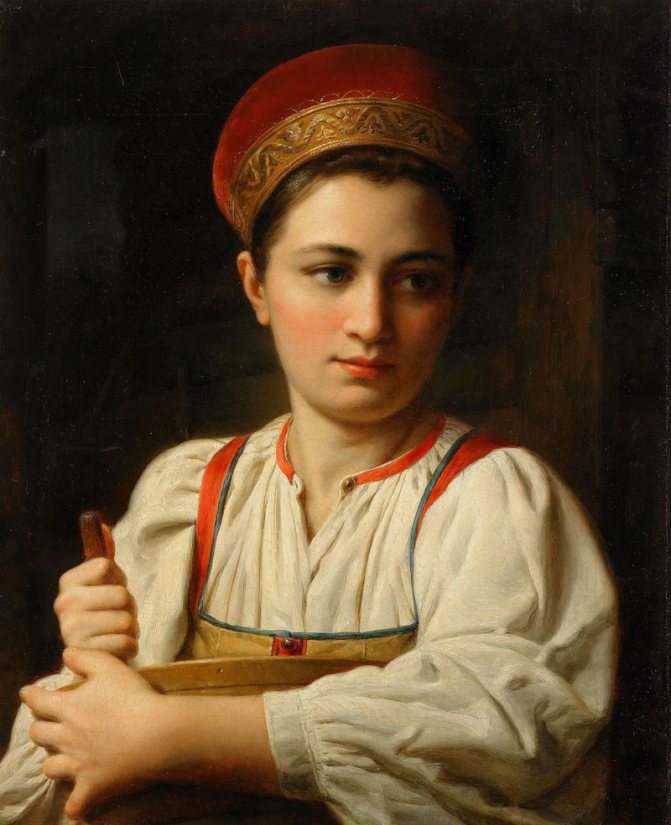
Peasant woman in a kokoshnik. Source: wikipedia.org
Moreover, in Rus', kokoshniks were almost immediately divided: lush and decorated with jewelry were worn on holidays, and ordinary ones - somewhat simplified and not so beautiful - were used in everyday life. Gradually, the price of such products decreased, and the kokoshnik began to appear in some villages: not only noble people, but also simple peasant women adorned their heads with it.
The kokoshnik was not only a piece of clothing, but also a kind of amulet for women: it was traditionally decorated with symbolic signs - fertility, marital fidelity and other characteristics that were believed to be inherent in a woman.
Since kokoshniks appeared in Rus', then, obviously, craftswomen should also appear to make them. “Kokoshnitsa” could most often be found either in a large village or at a monastery. The choice of kokoshnik was usually approached thoroughly and almost no such purchases were made by chance - due to the expensive fabric and pearls, the cost of the headdress was sometimes so high that it was kept as a family heirloom and passed on by inheritance.
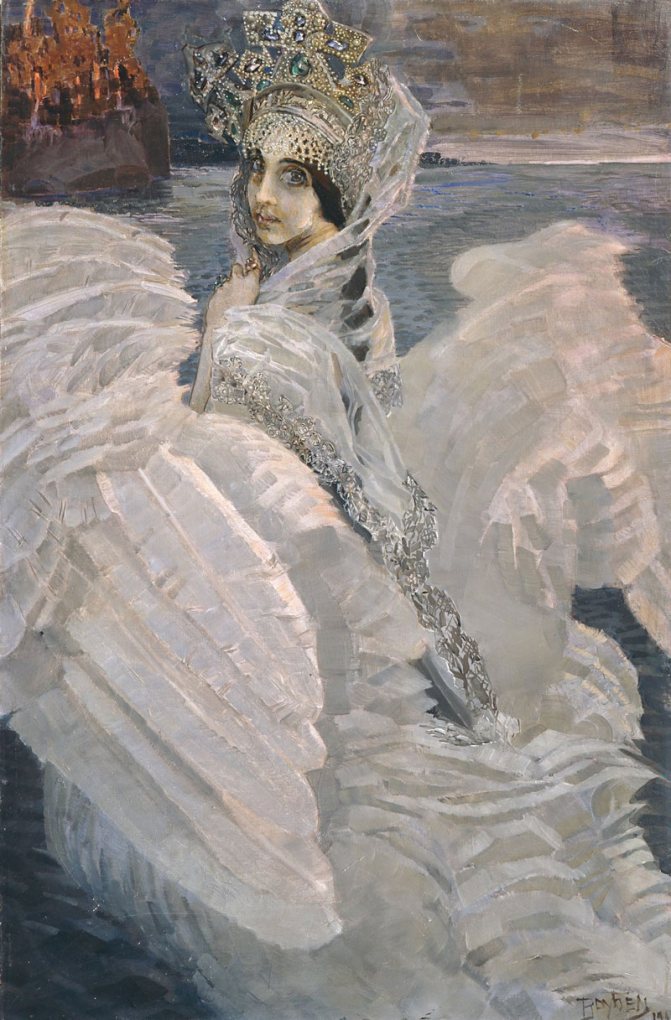
Swan Princess. M. Vrubel. Source: wikipedia.org
By the 17th century, “kokoshnik” had become an integral part of Russian costume, and the word itself had completely entered the language - it was even used in some official documents. However, the happiness of kokoshnik lovers did not last long: the formidable Tsar Peter I appeared on the horizon, whose reforms did not bypass the appearance of his subjects.
The wives of nobles and boyars had to say goodbye to their headdress, but in the villages no one inspected peasant women - there they continued to wear the kokoshnik. Nevertheless, the fashion, of course, was set by the aristocrats - and among them, from then on, the kokoshnik was worn only for some special rituals.
Despite the fact that Peter I practically banned kokoshniks, his followers - for example, Catherine II and Nicholas I - treated the headdress differently. The Empress, in order to show her closeness to the Russian people, posed in a kokoshnik in numerous portraits, and Nicholas, who made Russia the “gendarme of Europe,” introduced the kokoshnik into the women's court uniform - married ladies were required to wear it.
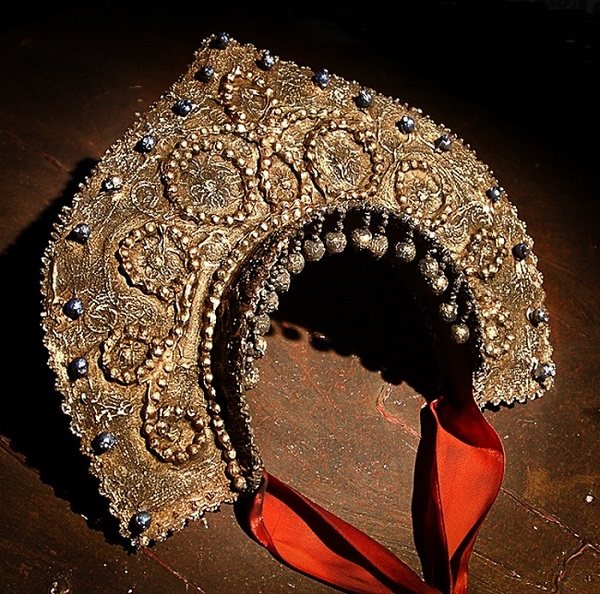
Kokoshnik decorated with pearls. (kulturologia.ru)
The kokoshnik existed as a headdress worn on major holidays until the beginning of the 20th century. The Bolsheviks, naturally, did away with this item of clothing, but at the same time the Europeans became closely acquainted with the kokoshnik: among the emigrants - apparently as a reminder of the lost homeland - it became extremely popular, which is why rich Russian ladies who continually opened their houses fashion somewhere in Paris, introduced it into their collections.
The kokoshnik has remained a symbol of Russia to this day: for example, during the FIFA World Cup, which took place in Russian cities in 2021, sales of kokoshniks soared to a fantastic level - foreign fans took it with them as a souvenir.
Jewelry Authentication
It is advisable to check the authenticity of the jewelry before purchasing.
Selling jewelry from a well-known jewelry salon already gives a 100% guarantee that you are purchasing an original, because not a single brand will risk its reputation and sell fakes. How else can you verify the authenticity of a product? Visual assessment
When checking jewelry, start with inspection. First of all, check for the presence of a tag, which is a certificate for the product. Additionally, a certificate is provided for precious stones of a certain carat value. The tag must indicate the fineness of the precious metal, the weight of the product, and the characteristics of the inserts.
The second important point is stamps. By law, all jewelry that goes on sale is branded. Each one is stamped with the name of the manufacturer, if the product is made in Russia, and an hallmark consisting of three elements (from left to right):
- letter code of the state inspection that conducted the testing;
- ID badge in the form of a woman in a kokoshnik, whose head is turned to the right;
- three-digit digital code corresponding to the metal standard.
For example, this is what the hallmark looks like (in the corner on the right) for jewelry made of 585 gold:
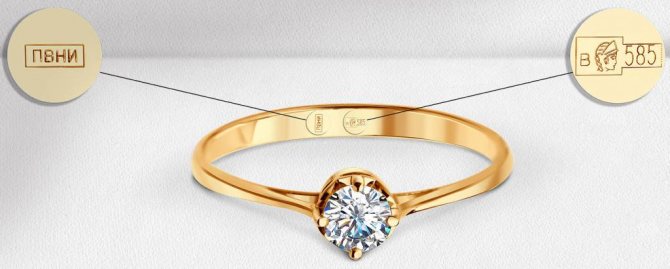
When visually assessing jewelry, pay attention to the quality of the setting of the stones, if any: the inserts must be precisely fixed in the frame, and in no case glued.
If it is a chain or bracelet, then its links must be soldered and have no gaps. The color and luster of the precious metal must be uniform. Checking jewelry: where to check
The conclusion of an independent expert is the only reliable one. For diagnostics in the laboratory, non-destructive testing methods are used, in particular spectral analysis, which shows which metal the specialist is dealing with. There are many other methods in the arsenal of an expert gemologist to determine the authenticity of precious metals and stones; these methods are usually used in combination. Based on the results of the inspection, a conclusion is issued that will give the owner of the jewelry a complete understanding of the painting.
Among our publications you will find articles devoted to checking the quality of jewelry made from various precious metals at home. For example, chromium peak is used to determine silver. Commercially available acid reagents can also be used to evaluate gold. The methods under consideration are less reliable than gemological examination, but they allow us to weed out fakes if the product was purchased secondhand or at a fair.
